
Discover more from Agent131711’s Substack
Demolishing the World's Fairs: the Most Fascinating Story You've Never Heard - Dynamiting History PART 2
Some of the craziest true history of all time. This will change how you view the world...
In Part 1 of this series we began discussing The World’s Fairs - a topic highly suppressed in school history books, so suppressed that I only recently learned of them and have been actively researching ever since because it is mind-blowing (it’s actually one of my favorite topics).
Hundreds of these incredible Fairs, also called Expositions, each spanning as much as 700 square miles, heavily took place in the 1800s and early 1900s and featured the most remarkable buildings you have ever never seen.
Even more impressive than the buildings themselves was the amount of time history claims they were constructed in; as little as a couple months to as much as a couple years…
To explain this, history claims these buildings were just temporary structures, quickly thrown together for the event…
To accompany the cheap, makeshift buildings, the fair organizers excavated land to create lakes, rivers, ponds, dams, locks and channels.
And created ginormous statues…
Every inch of the premises featured elaborate landscaping, including towering trees.
We are told that the buildings being temporary explains why they are no longer in existence…
Despite cheap buildings that were built in record time, hundreds of vendors and millions of patrons, these worldwide events almost all resulted in extreme financial loss for the economies they were hosted in, yet they continued to occur for over a century… and at the close of each event, every last trace of them completely vanished…
If you just found this article and haven’t read Part 1, you definitely want to start there. For the rest of us, it is now time to ask…
WHAT HAPPENED TO ALL OF THESE BUILDINGS?
Despite the US being at war and in assorted crisis’s during these fairs, all of the buildings on the fair grounds were contractually obligated to be demolished after the fair, costing even more money. For example, the demolition cost of the 1915 fair was over $461,000 (which is over $10 million in todays value):
The “Restoration Cost” was to restore the land to nothingness - and they acted quickly to accomplish this. For example, in St Louis, they brought in dynamite crews from Chicago and blew everything up the day the fair ended. Here are some of the temporary buildings that were dynamited:
Every last hallway, every last brick, every stone and pillar, all had to be destroyed…
…because these were just temporary structures…
…so it all had to go…
…even the murals, statues and sculptures could not be salvaged…
…because they too were just temporary…
…so due to the contractual obligation to leave no trace behind, the crews moved at breakneck pace to demolish every last remnant of every event…
And this wasn’t just happening in the USA, the demolition of incredible tax-funded events with temporary buildings occurred worldwide following all of the fairs. Even buildings which you would assume would be vital to communities, such as this huge hospital at the Berlin Fair, was demolished:
At this same fair, they began demolishing the theater while the fair was still open.
But few knew of the theater because the Berlin government unexplainably banned the theater from advertising during this time.
Then there was The Wine House Exhibit, a cheap copy of a real wine house, only made for the exhibition, therefore it also needed to be demolished. They did such a grand job building this one that it was physically embedded into the street, on a street containing other houses that were not part of the Fair:
It was demolished the day the expo ended... along with all of the other houses on the street.
The Paris Exposition buildings were quickly blown apart as soon as the fair ended:
At the Brussels International Exposition (1897), buildings collapsed as soon as the event was over. The identical occurrence happened at the San Francisco World’s Fair… they magically began falling over as soon as the last patron exited the gate. Were these buildings temporary buildings that were purposefully knocked over to prove the buildings weren’t real? Or did they start the demolition process early? I don’t know, but the timing is uncanny.
Then we have the Leipzig World’s Fair:
Here, the electricity stations collapsed only a few days after the end of the fair, so unfortunately, even those could not be salvaged for the people of Leipzig. But it wasn’t just the electricity stations that fell that day, even the electric circular track at this fair suddenly collapsed and could not be repaired for the citizens use.
The fairs that were not dynamited or did not collapse all had freak fires.
In 1851, the Crystal Palace at London World’s Fair burned down.
Citizens would report the fire burned so abnormally hot that there were streams of molten glass running away from the building.
Even the giant steel structure could not be salvaged…
…so it was ultimately destroyed…
Only a few years later, in 1858, a Crystal Palace at the New York World’s Fair also caught fire.
Another Crystal Place, located in South London, was struck down by fire.
In 1907, the Fair’s Park House burned due to “out of control fireworks”:
At the Missouri Exposition, the magnificent pavilion went aflame and could not be saved.
The Philadelphia World’s Fair fire was so extreme that, in addition to incinerating the fair, it demolished two major cities:
At Chicago’s World’s Fair, the entire “city” caught fire…
…it all was destroyed…
And this wasn’t the first fire.
The same Fair featured a massive 35 track system…
From what I understand, it was the biggest track system in history as of the time:
(inside view of station)
…this also burned, and it has a story of its own: A security guard named C. Mason saw the fire and tried to sound the alarm but all 5 of the devices used to activate the alarm were not working that day. The cause of the fire? Intentional arson. When it was time to disassemble what was left of the train station, the power stations and railways were removed first.
Surprisingly, this was not the only power station to disappear. The tower of Dresden District Heating Station was not associated with a World’s Fair, but it suffered the same fate:
Because the government claimed the power station “was no longer needed”, after the arson it was never replaced.
I noticed that these fairs, which seem to almost all resulting in financial loss and destruction, started as just a few a year:
Then progressed:
Then, by the 1880s, they were back-to-back, worldwide. This means, all over the earth, cities wanted to throw disaster-fairs, despite few-to-none of their predecessors being positive for the community:
There is no possible way I can research every fair, so I randomly clicked on a couple from the Wikipedia list to see what happened with them. I discovered that, at the South African International Exhibition of 1877, “a fire broke out near the theatre entrance. In less than one hour, the entire building was destroyed, along with the adjoining Masonic Lodge and Native Affairs Office”.
Next I clicked on the Cotton States and International Exposition of 1895.
Apparently, construction took only a few months:
This included the installation of a lake.
Incredible temporary buildings at this one too:
No fire broke out, but after the event all of the buildings were quickly demolished per the contract.
Next I selected the Pan-American Exposition of 1901:
This one was 350 acres and taking only two years to complete:
I stole borrowed this 11-minute video from the Library of Congress so we can see the temporary structures. I strongly encourage you to skim through it:
What was the fate of the Pan-American Exposition of 1901? You’re probably thinking, lemme guess, another fire? Yes sir. On September 6th of 1901 a large blaze broke out and quickly engulfed everything leading to “significant financial losses, estimated to be around $1 million (approximately $28 million in today’s dollars).” - the good news is they didn’t have to dynamite it! (I’m kidding. I’m sure they still brought in the Chicago Wrecking Crew to ensure everything was leveled.)
THE BUILDINGS LEFT STANDING… ALSO BURNED
The Park House was a temporary exhibit at a World’s Fair:
Surprisingly, this building was left standing after the rest of the fair was leveled but… it burned down a few years later due to an “accidental fire”. This fire was also caused by fireworks that went out of control. (1907)
The Electrical Building was another jaw-dropping structure that was left standing and, despite being just a temporary building, miraculously survived all the way into 1978 when it too went up in flames. The cause was “youth arson”.
The same year, 1978, the Globe Theater also burned down… also due to arson…
People sure like burning down historic buildings, eh? If only the kids of the 1970s had Xboxes for entertainment…
The Paris Exposition had a story unlike the rest. The land the Fair was on was labeled “military land”, therefore it was under military control and after the fair the public was prohibited from it. And as if this story could not possibly get any more bizarre…
THE “EXACT REPLICAS”
The public was typically unaware that the breathtaking fair buildings were going to be demolished because they looked so real and, when they found out, they were rightfully outraged (I suspect this is exactly why they began the destruction process so quickly). So, you can’t make this sh*t up: to stop the public from protesting, the fair organizers said they would demolish them all then rebuild a few of the structures. They went on to assure the public that the rebuild would be identical to what was just destroyed - this strange idea pacified the public… until the end result was produced...
At the Universalle Exposition everything was demolished but, in 1900 they rebuilt the exact same things, however, citizens were upset because what they rebuilt was nowhere near as nice as the originals and nobody understood why they couldn’t just build back the same buildings as they promised to do. After all, they just built all of those buildings, so rebuilding them should be a breeze!
Another example of this was a cigar company exhibit from a Germany Expo. This building was demolished immediately following the close of the fair:
To get the public to shut up about it, they built then presented this to the people as “an exact replica”:
The people were livid because the new building, although featuring a similar structure, did not have the ornate detail or “feel” of the demolished building. They expressed that the materials used to create the exact replica were not the same. And to make the whole issue even more perplexing, it was allegedly the cigar company who volunteered to cover the cost of the demolition and rebuilding the exact duplicate. Speaking of recreating history…
WORLD’S FAIRS OF THE 1960s
In the 1960s, history threw two more World’s Fairs, one in New York and one in Washington. These fairs were to be exactly like the old fairs and every bit as impressive. The fair organizers promised that these events would be a rare glimpse into the past; an opportunity to walk through the 1800s, but even better because, due to so many advancements in technology, we could recreate the exact experience, yet offer it alongside modern amenities - sounds pretty awesome to me.
Like the other fairs, the 1962 World’s Fair in Seattle took two years to build, but the differences were noticeable, to say the least. For starters, it spanned only 74 acres and - well how about instead of telling you, I just show you this monstrosity….
And 3… 2… 1…
REVEAL!:
Yeeeah… it featured cheesy tents, balloon-roofs and minimal landscaping. After cringing you say, “Well, maybe it wasn’t that bad. Do you have any photos of the actual fair?” - of course I do, milady. Instead of just looking at fair pics, let’s compare the 1962 World’s Fair in Seattle to the 1893 World’s Fair in Chicago. Here’s 1962:
And here’s 1893:
In all fairness, they might not have had balloon-roofs back then…
Here’s Canada’s exhibit in 1962 featuring an embarrassingly awful little statue - shame on you Canucks!:
versus the Canadian Showcase in 1893:
And here’s the Canada Exhibit at the same event (yeah, they had a showcase and a building too):
How about The Germany Exhibit of 1962?:
Compare that to the Germany Exhibit of 1893:
In ‘62, other than the stupid Space Needle, the most showy piece of art at the Fair was “The Federal Science Pavilion: a virtual cathedral of science", which was this garbage they called art:
But here’s art from 1893:
The New York World’s Fair in 1964 was just as unimpressive:
Let’s compare this fair to the Louisiana Purchase Exposition of 1904. Here’s the Transportation Pavilion in 1964:
Versus the Palace of Liberal Arts in 1904:
Here’s the 1964 Fair’s landscaping:
Here’s 1904:
1964’s tent buildings:
1904:
1964 decor:
Here’s 1904 decor:
Can we agree something isn’t adding up here? NEXT READ: Exposing the World’s Fair Construction Photos & Impossible Buildings (Part 3), but first, if you appreciate the endless hours I put into creating content you don’t see elsewhere, please consider supporting my efforts. Every dollar helps me afford better equipment, external storage and more:










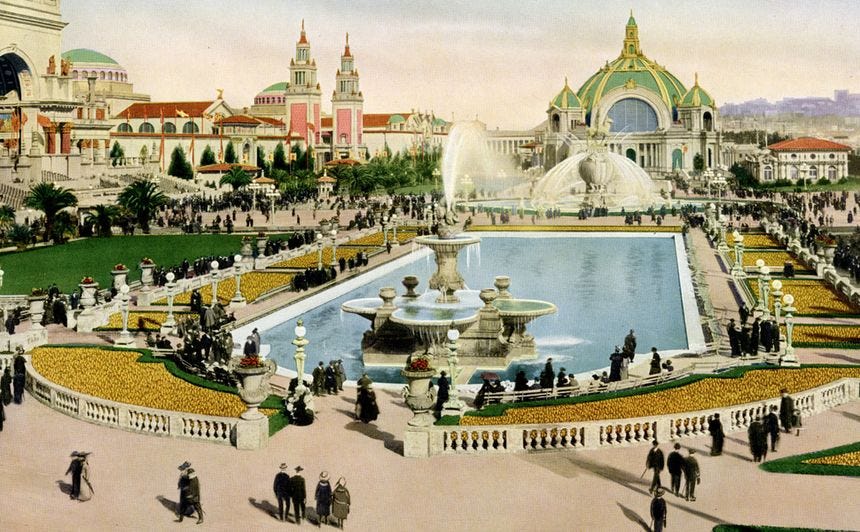










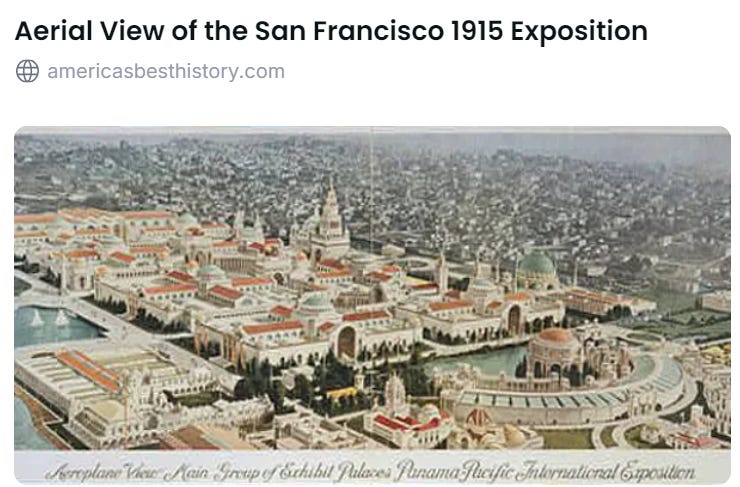



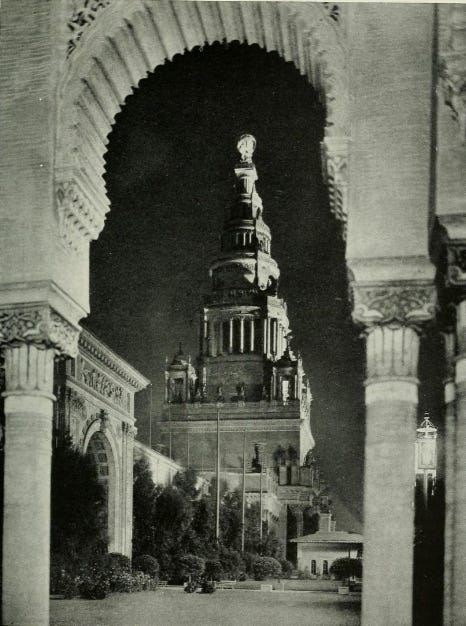











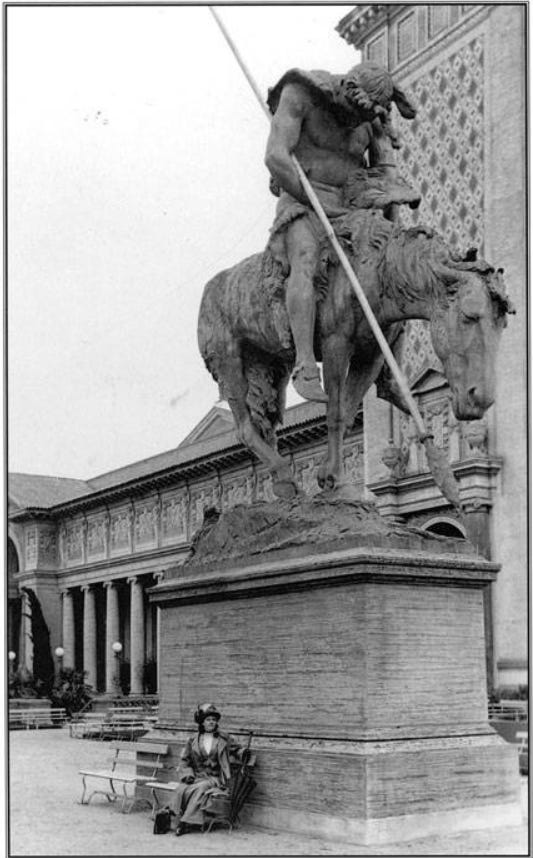








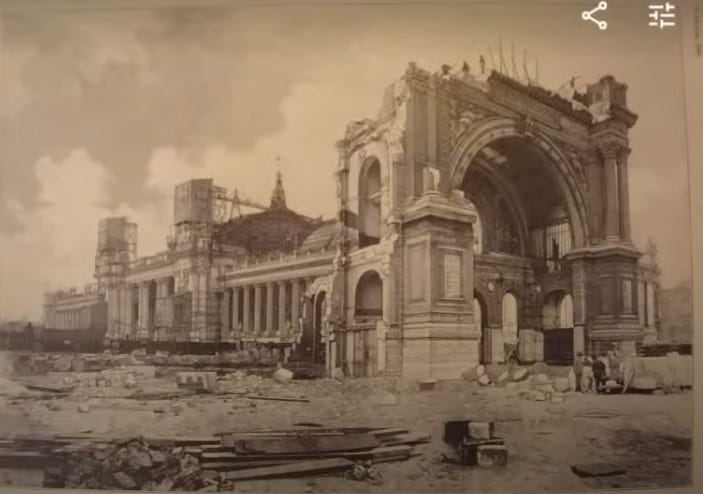




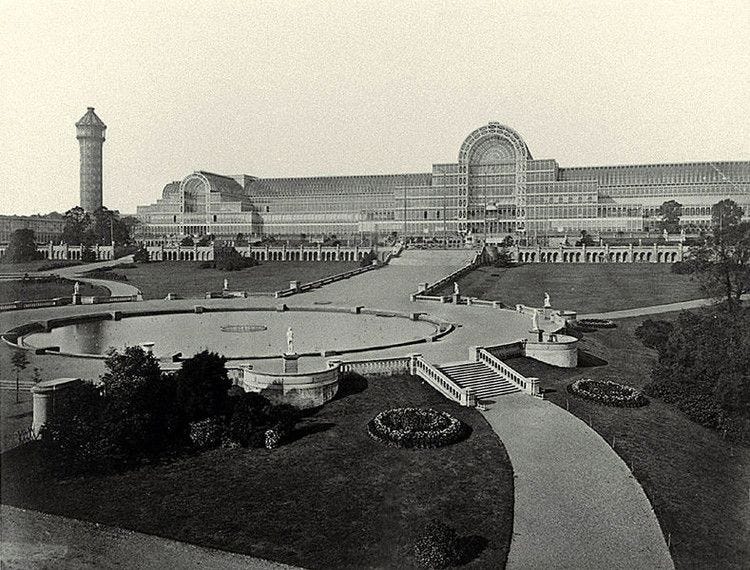
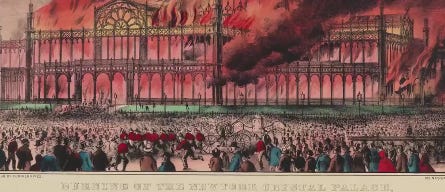
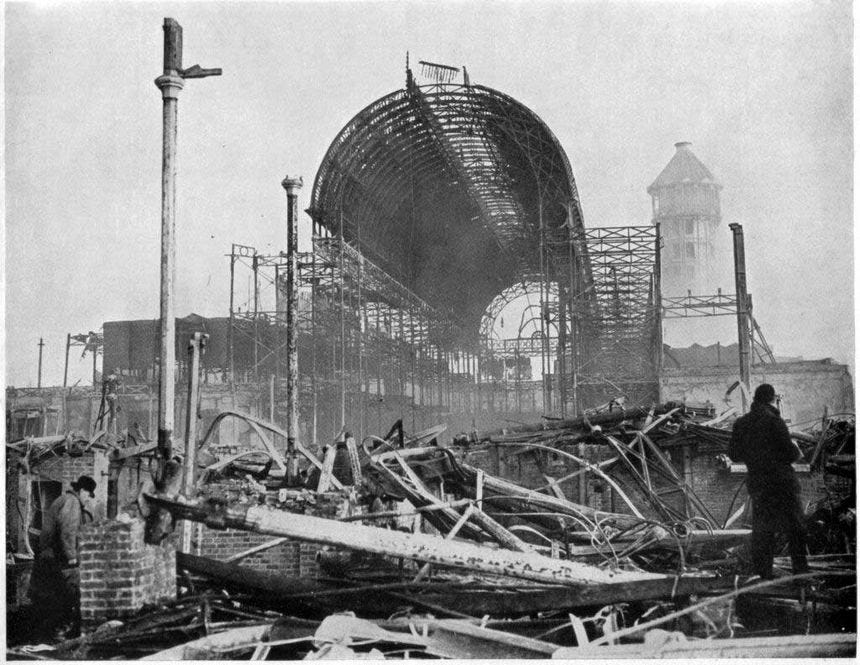




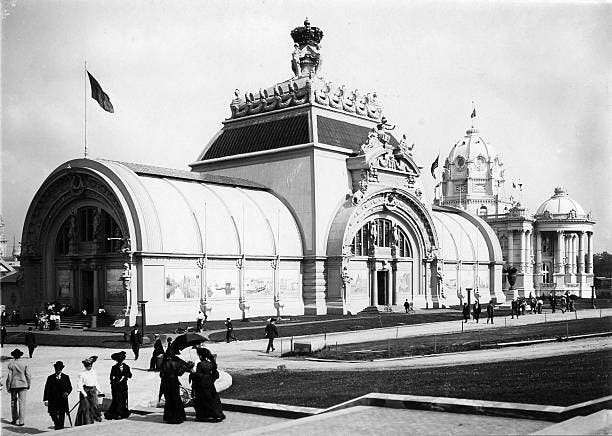




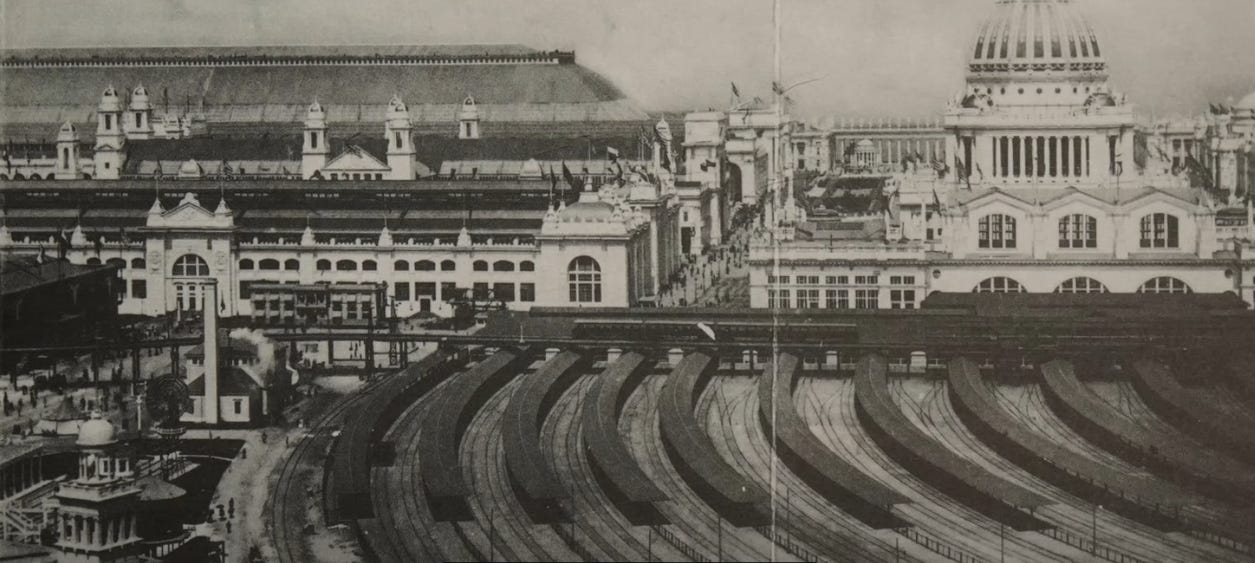
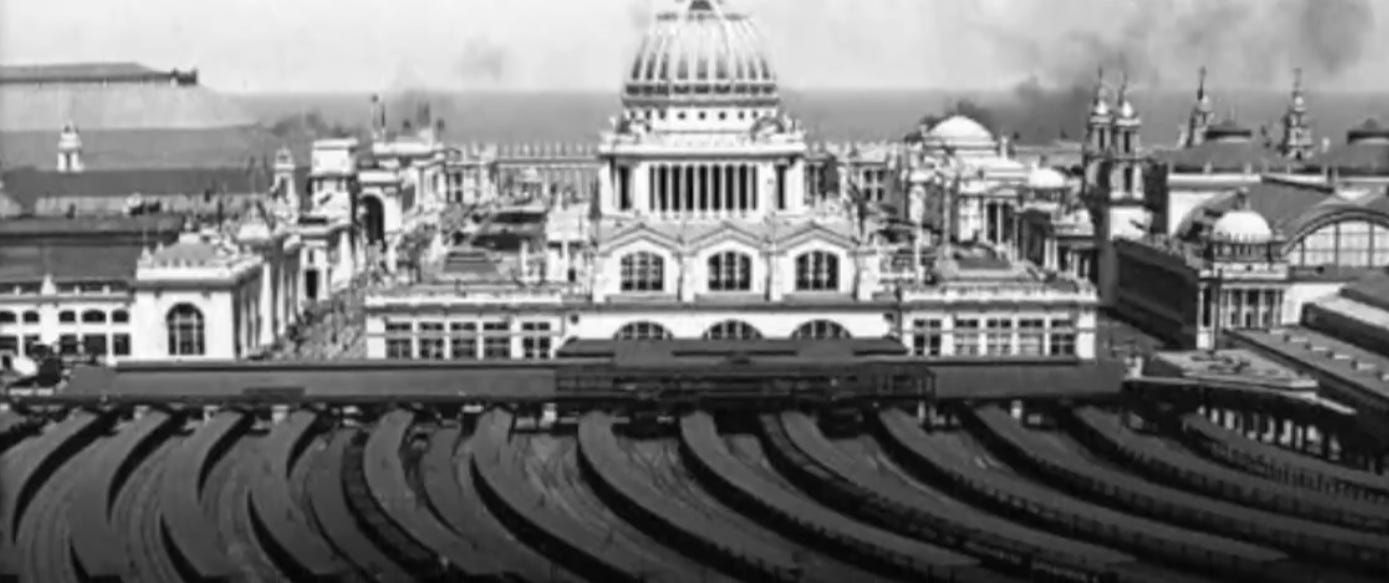


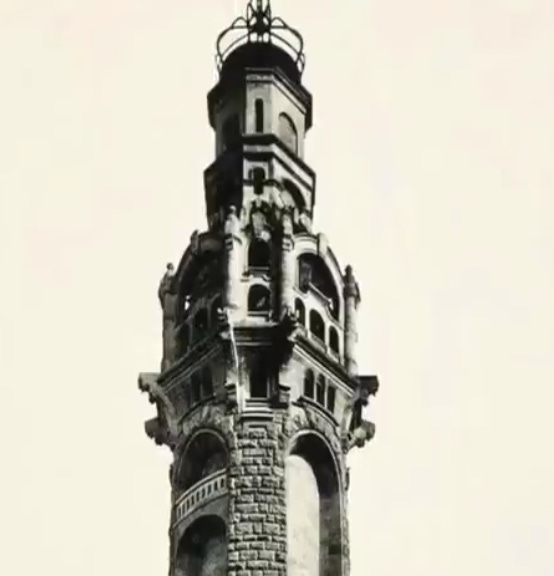






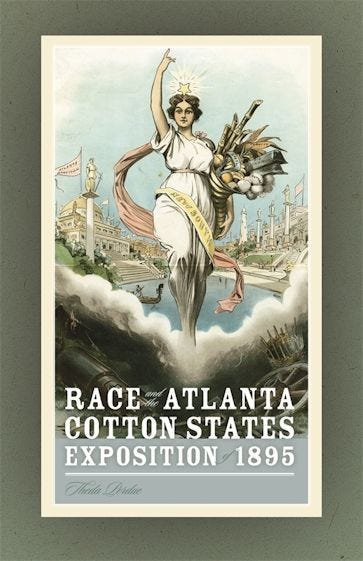














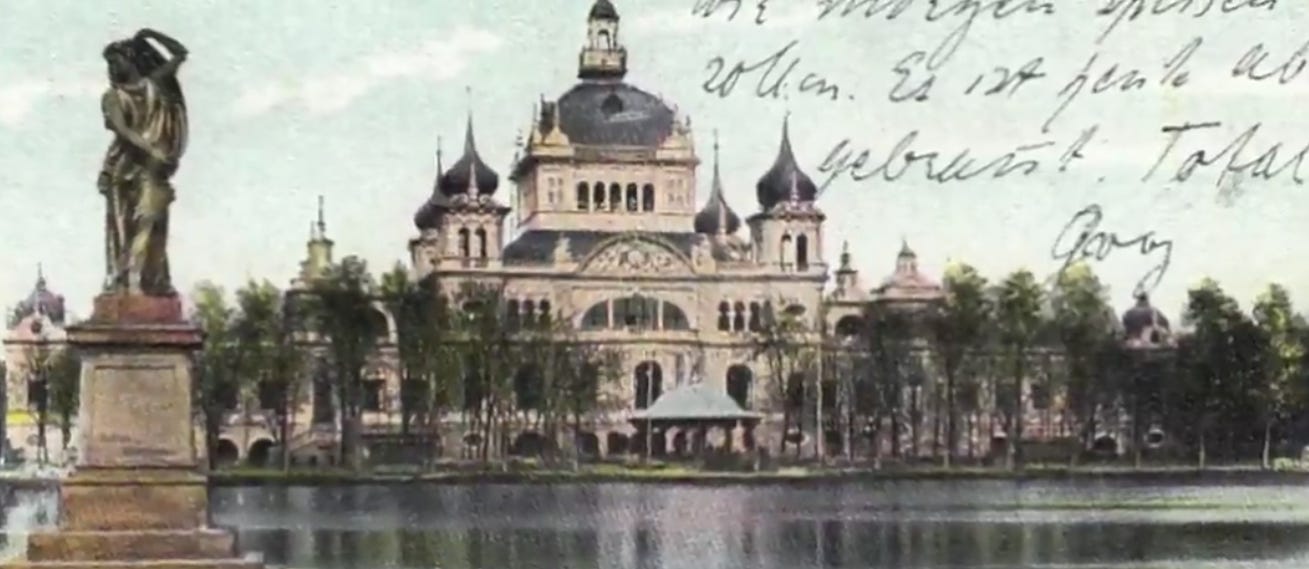




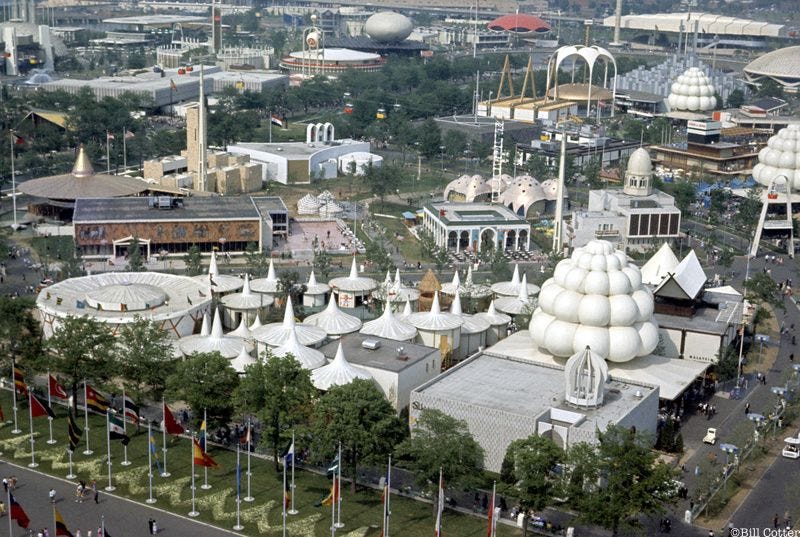

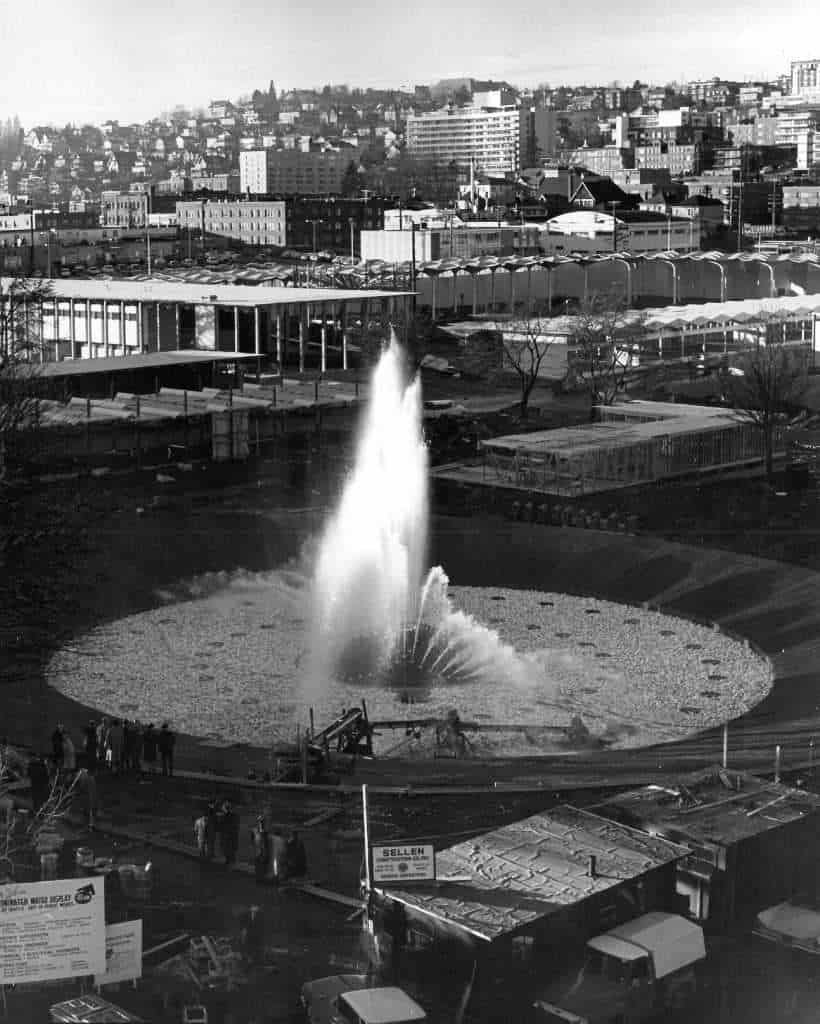



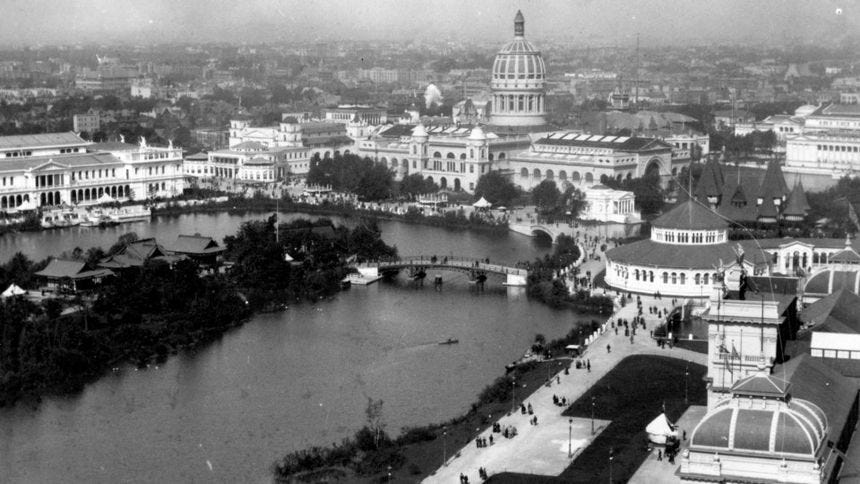





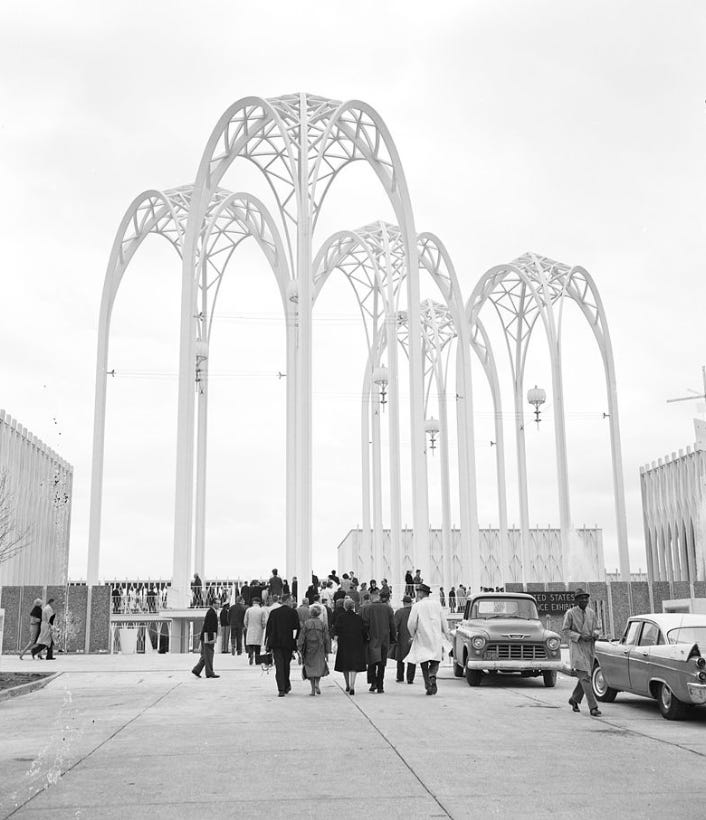
















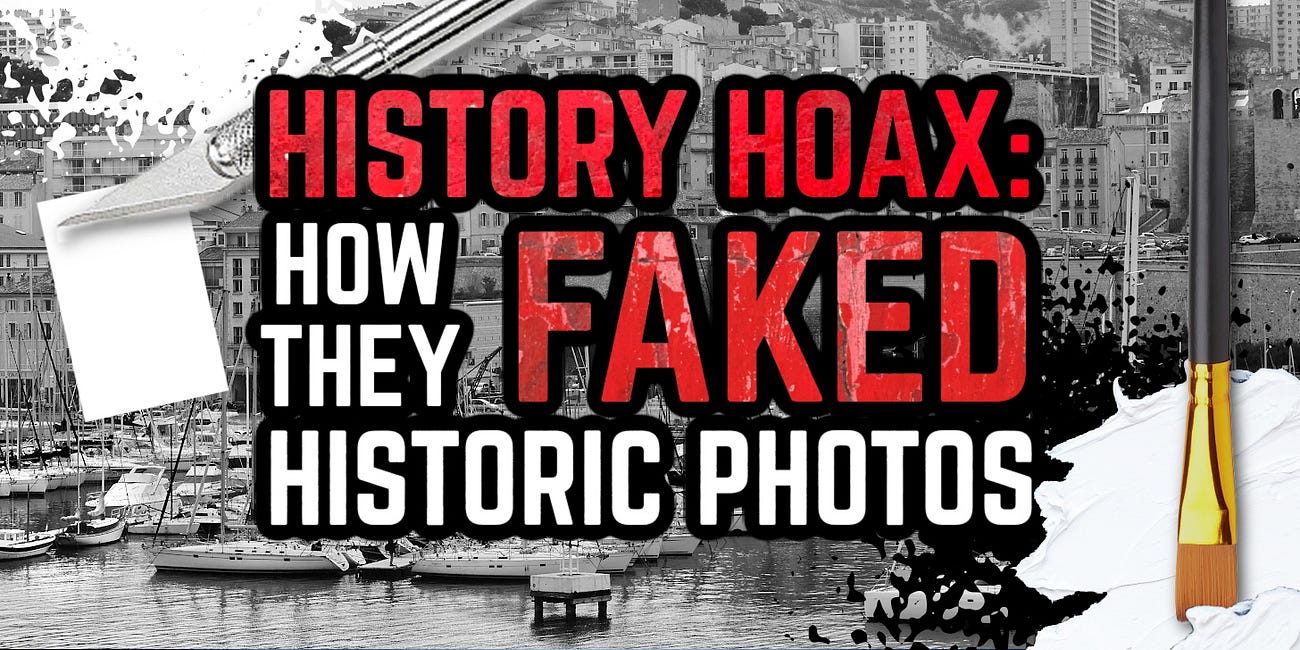







One of the ways to Demoralize and therefore control a population is by destroying beauty and replacing it with square, unadorned buildings and telling you that is Modernism. That's the Psy-op.
Best article series yet! I am obsessed with this topic and it's hard to find good photos... it's great to have so many in one place.
I can't quite wrap my mind around what happened here but something definitely doesn't add up.
The comparisons to the 1960s fairs is priceless!
Looking forward to next topic.